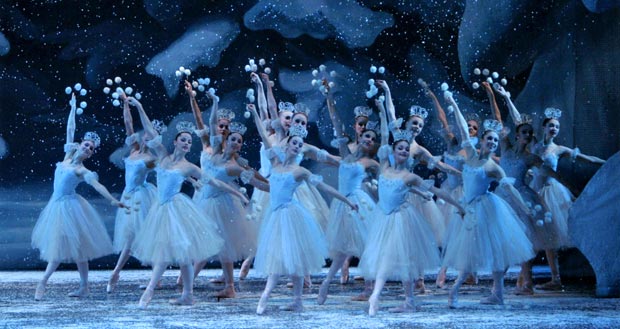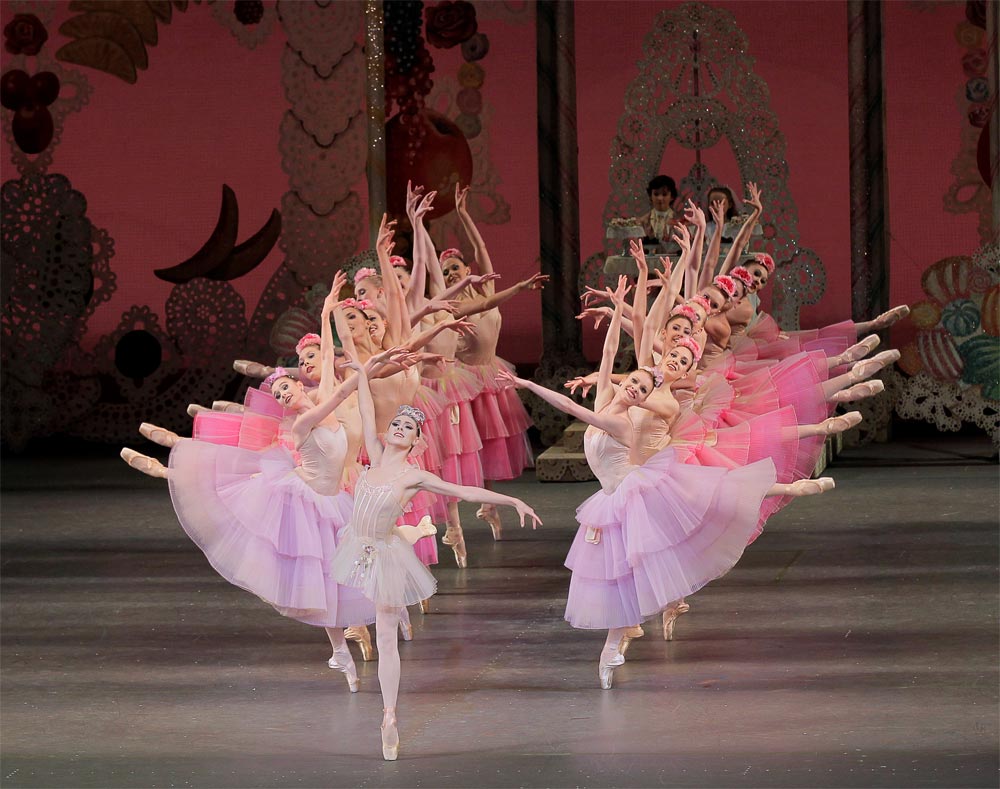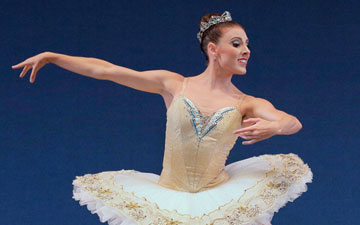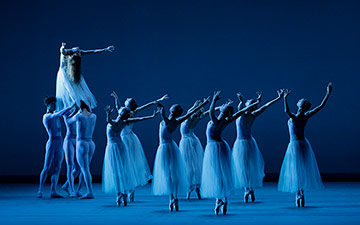
© Paul Kolnik. (Click image for larger version)
And then Came Dewdrop
New York City Ballet
George Balanchine’s The Nutcracker
New York, David H. Koch Theater
23 November 2012
www.nycballet.com
When something is beautifully made it never gets old. So it is with Balanchine’s Nutcracker, first performed by New York City Ballet in 1954 and honed to near-perfection over the years. There are good performances, bad ones, and every so often a magical one, but even a middling one will do, because the structure is sound. First, there is Tchaikovsky’s score: imaginative, filled with whimsy, but also, without warning, steeped in drama. Balanchine’s interpolation of the yearning violin cadenza from The Sleeping Beauty into the scene in which Marie falls asleep with the Nutcracker in her arms is so seamless, and feels so appropriate, that one would never guess the music had been smuggled in from another ballet. The balancing-act of the first half, with its social dances and children’s games quickly replaced by a dream-world filled with danger and death – in miniature – is just right. Real life, Balanchine tells us, is only a step away from fantasy. Excitement tips into drama with little notice.
Then there are the children, lots and lots of them, beautifully trained and serious, doing little emboîtés and waltzing and jumping in arabesque, feet energetically pointed. Year after year, they graduate from one role to the next, from angels and party guests to polichinelles and candy canes. One sees them learning the craft of ballet, as well as its courteous worldview. The ballet belongs to them, and to the children in the audience who see themselves reflected by their onstage avatars. It is the ultimate introduction to the world of ballet.
Balanchine knew the power of illusion; for him, the magic tree that grows and grows – to monstrous proportions – was the crucial element of the ballet. And he was right; it still moves the soul, abetted by Tchaikovsky’s ascending phrases, a crescendo that will not be denied. (Marie, the stand-in for every child with an imagination and a tender heart, is both drawn to, and terrified by, the tree.) But there are other, more quiet, examples of magic: the spinning bed; the blinding paper snowflakes, so treacherous to dance in; the sudden on-stage costume change that turns the Nutcracker into a tiny, pink prince; and best of all, the hidden platform that allows the Sugarplum Fairy to glide like an ice-skater, in perfect arabesque on pointe. These tricks don’t require much: an elevator, a stagehand hidden under a bedskirt, a few cables. And yet they’re terribly effective. They become indelibly inscribed in our memory. We can just imagine what it must feel like to lie on that bed like little Marie and glide off into the woods, surrounded by that sumptuous music.

© Paul Kolnik.
Last night (Nov. 23) was the opening performance of New York City Ballet’s Nutcracker season, which runs through December. As the series progresses, younger and greener dancers will be given the chance to test their mettle. The first cast had no big surprises and was danced with polish throughout. The ballet is the company’s lifeblood, and a well-calibrated machine. Of the second-act divertissements, Hot Chocolate, led by Georgina Pazcoguin and (especially) Chase Finlay stood out for its full-bodied, fiery execution. These were Spanish dancers with style and pizazz. Rebecca Krohn was a comely, seductive Arabian Coffee, more pinup than harem girl. Robert La Fosse returned to play his whimsical rendition of Herr Drosselmeier, a role he refines and subtly re-casts with every passing season. It must be said that it is a pleasure to watch him create his little world onstage. This year’s Marie and her Nutcracker Prince – Claire Abraham and Lleyton Ho – were particularly tiny; F. Henry Berlin was a rambunctious Fritz. Like all the children in the show (all of whom study at the School of American Ballet) they were wonderfully precise and refreshingly un-ingratiating. Abraham (Marie) managed to nail the Mouse King right on the nose with her slipper. Ho was attentive and gentle, even in the party scene: a real princeling, worthy of Marie’s affection. And his long mime sequence in the second act – in which he recounts the events of the first – was a coup de théâtre, a model of clarity.
In a way, one doesn’t judge the dancing in Nutcracker the way one does in other ballets; it’s not really the point. More important is the spirit that shines through. The Sugarplum Fairy is less a ballerina than a symbol: womanhood in all its resplendent glory. But it helps if she is not only resplendent but warm. The best Sugarplums have the openhearted manner of a fairy godmother. Alas, Maria Kowroski, for all her glamour and her long lines, does not really have this quality. At least on this night, the role did not capture her imagination, nor did she let herself be carried by the music. A certain dutifulness crept in.

© Paul Kolnik. (Click image for larger version)
In terms of pure dancing the high point of the evening was Tiler Peck’s whirlwind turn as the Dewdrop in the Waltz of the Flowers. As soon as she entered, surrounded by her tulle-engulfed attendants like a water nymph in a mountain spring, the story disappeared and the ballet became, at least momentarily, a pure expression of movement and music. As in the snowflake waltz, Balanchine’s choreography rides a musical wave. But here he has added a dramatic, swooping through-line, a figure that appears and disappears with a whoosh and leaves you gasping for more. Peck seems to swim through space. She dances with a powerful force behind her, a current that pushes her from one movement into the next. That current is the music. At the same time she shapes time, holding one position as long as humanly possibly, then blazing through the next sequence. She shows no effort. The choreography simply is; she reveals it to us. As she danced time seemed to stand still. Her performance allowed us to glimpse something beyond the story: the heart-catching excitement of movement, the reason why ballets are made in the first place.

















I saw the Nutcracker in London and in Moscou and, so sorry for yours… but it seems the final Academy Ballet Cours of little children dancing for their parents and family. I paid more than 300 $ for nothing and of course I left the theatre before finishing the second act ,and, I was not the only one. I was there th 12 December 2012. 7 p.m.